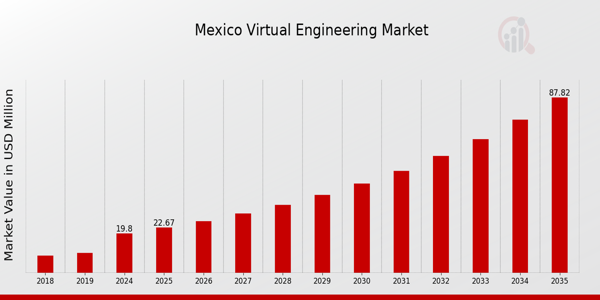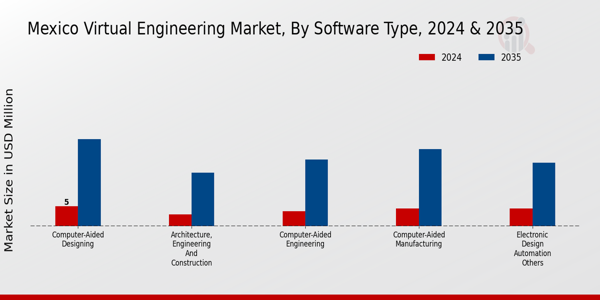Mexico Virtual Engineering Market Overview
As per MRFR analysis, the Mexico Virtual Engineering Market Size was estimated at 17.11 (USD Million) in 2023.The Mexico Virtual Engineering Market Industry is expected to grow from 19.8(USD Million) in 2024 to 87.84 (USD Million) by 2035. The Mexico Virtual Engineering Market CAGR (growth rate) is expected to be around 14.502% during the forecast period (2025 - 2035).
Key Mexico Virtual Engineering Market Trends Highlighted
Advancements in technology, particularly in automation and digitalization across various sectors, are driving significant growth in the Mexico Virtual Engineering Market. The demand for virtual engineering solutions to improve productivity and efficiency is on the rise in Mexico as industries progressively adopt Industry 4.0 principles. The adoption of virtual tools among local enterprises has been facilitated by the federal government's promotion of initiatives to modernize manufacturing through digital transformation.
Furthermore, the growing emphasis on sustainable practices is compelling organizations to investigate inventive engineering solutions that mitigate energy and waste consumption. In this changing environment, there are numerous opportunities, particularly for small and medium-sized enterprises (SMEs) that can capitalize on virtual engineering to maintain their competitive edge.
Virtual prototyping and simulation tools can be employed by these businesses to optimize product development and reduce costs. Furthermore, the education and training sector in Mexico is increasingly acknowledging the significance of providing the workforce with the requisite skills for virtual engineering, thereby establishing a talent pool that can encourage further innovation.
The most recent trends suggest a transition to collaborative engineering environments, in which teams can collaborate remotely on projects. The prerequisite for businesses to adjust to flexible work practices is the driving force behind the rise in remote collaboration. Furthermore, the integration of artificial intelligence and machine learning into virtual engineering is becoming increasingly common, enabling data-driven decision-making processes. The virtual engineering market is on the brink of sustained growth as organizations in Mexico continue to adopt these technological advancements. A variety of industries are recognizing the strategic value of these solutions in improving their operations.

Mexico Virtual Engineering Market Drivers
Rising Adoption of Advanced Technologies
The Mexico Virtual Engineering Market Industry is witnessing a significant increase in the adoption of advanced technologies such as Artificial Intelligence (AI), Internet of Things (IoT), and cloud computing. The Mexican government has implemented the Digital Mexico initiative, aimed at promoting the digital economy, which has resulted in a 35% growth in technology-related businesses over the past three years.
This growth leads to increased demand for virtual engineering solutions, as companies move towards modernization and efficiency enhancement.Additionally, major players like Siemens and General Electric are investing in local partnerships to develop cloud-based engineering solutions tailored to Mexican enterprises. Local universities are also integrating these advanced technologies into their curriculums, fostering a skilled workforce that can leverage these solutions, thereby accelerating the growth of the Mexico Virtual Engineering Market Industry.
Government Investment in Infrastructure Development
The Mexican government has increased its investment in infrastructure development, with plans to allocate approximately 1.1 trillion Mexican Pesos for various construction projects by 2024. This focus on infrastructure presents a significant opportunity for the Mexico Virtual Engineering Market Industry, as engineering firms seek to utilize virtual engineering tools for project management, design visualization, and collaboration.
Notable engineering companies such as Grupo Carso and CEMEX are at the forefront of utilizing virtual engineering solutions in these projects, thus driving demand for enhanced engineering capabilities and innovative solutions that can not only offer better project outcomes but also reduce costs and execution time.
Growing Importance of Sustainability Practices
There is an increasing emphasis on sustainability within the Mexico Virtual Engineering Market Industry, driven by both global trends and local government regulations aimed at environmental conservation. According to the Mexican Secretariat of the Environment, more than 25% of new engineering projects must adhere to green building practices.
This need for sustainable practices leads companies to adopt virtual engineering tools that can simulate environmental impacts and optimize resource usage.Companies like Arup and EcoStruct are leading the way in sustainability and are employing virtual engineering to enhance project feasibility while aligning with these regulations, which in turn propels the growth of the Mexico Virtual Engineering Market Industry.
Industry 4.0 Transformation
The transformation towards Industry 4.0 in Mexico is heavily influencing the Mexico Virtual Engineering Market Industry, as more enterprises modernize their operations with smart manufacturing and automation technologies. According to the National Institute of Entrepreneurs, over 40% of Mexican manufacturers are in the early stages of adopting Industry 4.0 technologies, enhancing their manufacturing processes through virtual simulations and digital twins.
Major corporations such as Flextronics and Panasonic have already begun integrating these innovative approaches to streamline production. This transition emphasizes the necessity for advanced virtual engineering solutions, contributing to robust growth in the Mexico Virtual Engineering Market Industry as companies seek competitive advantages in global markets.
Mexico Virtual Engineering Market Segment Insights
Virtual Engineering Market Software Type Insights
The Software Type segment in the Mexico Virtual Engineering Market has shown a robust trajectory, with various software solutions playing a crucial role in enhancing efficiency and productivity across multiple industries. Within this segment, Computer-Aided Designing (CAD) stands out as an essential tool in fields like architecture and manufacturing, facilitating precise design and layout creation which is pivotal for the development of intricate projects. Meanwhile, Computer-Aided Manufacturing (CAM) is significantly influencing productivity in the production sector by optimizing manufacturing processes, enhancing accuracy, and minimizing waste, thus driving growth in this area.
The Computer-Aided Engineering (CAE) sector is also becoming more prominent, enabling engineers to perform simulations and analyze performance metrics, which aids in minimizing costs and enhancing product development timelines. The Architecture, Engineering, and Construction (AEC) segment is increasingly reliant on advanced software solutions to streamline workflows and improve collaboration among teams, ultimately leading to higher project success rates. Electronic Design Automation (EDA) is critical in the electronics industry, automating the designing process for circuit boards and integrated circuits, which is vital as technology evolves and electronic devices become more complex.
Each of these areas addresses specific needs within industries, making them significant contributors to the overall efficiency and advancement of engineering practices in Mexico. The increasing adoption of these technologies reflects a broader trend toward digital transformation across sectors, driven by the need for innovation and competitiveness in the global market. Moreover, Mexico's expanding manufacturing sector, combined with supportive government initiatives aimed at fostering technology and innovation, presents substantial opportunities for growth within the Software Type segment, promising advancements in quality, productivity, and sustainability.Overall, the Mexico Virtual Engineering Market segmentation shows a dynamic and evolving landscape, where software solutions continue to redefine how industries approach engineering challenges in a rapidly changing economic environment.

Virtual Engineering Market Deployment Type Insights
The Mexico Virtual Engineering Market demonstrates a noteworthy focus on Deployment Type, which is crucial for adapting technology solutions to meet the needs of various industries throughout the country. The significant segmentation includes On-premises and Cloud deployments, each catering to distinct market demands. On-premises solutions typically appeal to organizations requiring strict control over their data security and customization options, which aligns with Mexico’s emphasis on regulatory compliance in sectors like manufacturing and healthcare.Conversely, the Cloud deployment is significantly gaining traction, driven by its scalability and cost-effectiveness, enabling businesses to leverage advanced technologies without substantial upfront investments.
This segment is pivotal as it supports remote collaboration, addressing the growing trend toward digital transformation in Mexico. Additionally, the market's progression toward Cloud solutions is stimulated by increasing internet penetration and support from government initiatives focused on enhancing digital infrastructure. The parallel growth of both deployment types illustrates the Mexico Virtual Engineering Market's diverse landscape and highlights the increasing importance for businesses to choose the right deployment strategy to thrive in an increasingly competitive environment.
Virtual Engineering Market Organization Size Insights
The Mexico Virtual Engineering Market demonstrates a diverse landscape shaped by organizational size, with small and medium-sized enterprises (SMEs) and large enterprises playing significant roles. SMEs often leverage virtual engineering solutions for agility and innovation, enabling them to compete effectively against larger players. They benefit from cost efficiency and access to advanced technologies that scale alongside their growth. On the other hand, large enterprises dominate the market due to their robust financial resources, allowing for substantial investments in cutting-edge virtual engineering technologies and Research and Development initiatives.
This segmentation reflects the country's broader economic structure, where SMEs account for a substantial portion of employment and GDP. Additionally, as Mexico continues to push towards digital transformation, both segments are experiencing a rise in adoption rates, enhancing productivity and operational efficiency. The presence of a skilled workforce and collaborative opportunities in Mexico further bolster the market, making it an attractive region for virtual engineering advancements.
Virtual Engineering Market Application Insights
The Mexico Virtual Engineering Market is witnessing significant growth in its Application segment, which encompasses various areas including Automation Design, Plant Design, Product Design, and 3D Modeling. Automation Design is a crucial aspect of the market, enhancing efficiency and productivity in manufacturing processes. Plant Design plays an integral role as well, driven by Mexico's robust industrial sector and the increasing demand for optimized operational workflows in manufacturing and processing plants.
Furthermore, Product Design is vital for innovation, enabling companies to develop advanced products that meet consumer needs.3D Modeling is particularly significant, as it allows for detailed visualization and simulation, which are essential for effective planning and design in engineering projects. Other applications within this segment also contribute to the expansion of the Mexico Virtual Engineering Market by accommodating various industry needs and fostering technological advancements. The Mexican government’s initiatives to promote digital transformation and the growing demand for engineering solutions across sectors are further bolstering this market's potential, indicating a diverse and robust environment for virtual engineering applications.
Virtual Engineering Market Industry Vertical Insights
The Industry Vertical segment of the Mexico Virtual Engineering Market is witnessing robust growth, driven by the increasing demand for innovative solutions across various sectors. The Commercial Industry Vertical plays a crucial role in shaping the market dynamics, focusing on enhancing productivity, reducing operational costs, and improving user experience through technological advancements such as simulation and modeling. This sector is pivotal as it caters to diverse industries, including manufacturing, automotive, and architecture, fostering significant efficiency gains and competitive advantage.Meanwhile, the Defense Industry Vertical is becoming increasingly prominent due to rising investments in military capabilities and modernization programs.
This segment emphasizes the critical need for advanced virtual technologies to aid in design, testing, and resource optimization while ensuring national security. Both segments are integral to the Mexico Virtual Engineering Market's overall growth, addressing essential needs for innovation and operational excellence, thereby contributing to the overarching market statistics and fueling its expansion through strategic developments and governmental support initiatives in technology and defense sectors.The importance of these Industry Verticals lies not only in their contribution to market growth but also in their capacity to drive technological advancements and improve the competitive landscape in Mexico.
Mexico Virtual Engineering Market Key Players and Competitive Insights
The Mexico Virtual Engineering Market is characterized by a dynamic and rapidly evolving landscape, where technological innovation and digital transformation are accelerating the adoption of virtual engineering solutions across various sectors. Competitive insights within this market reveal a growing emphasis on enhancing product development processes, optimizing resources, and improving collaboration among teams through advanced virtual engineering tools. As organizations strive to enhance efficiency and reduce time to market, the integration of virtual engineering methodologies is becoming increasingly pivotal.
In this environment, companies are focused on leveraging software and technology to offer scalable and robust solutions that cater to unique local industry needs, thus solidifying their competitive positioning in Mexico.PTC has established a significant presence in the Mexico Virtual Engineering Market, capitalizing on its strengths in product lifecycle management (PLM) and computer-aided design (CAD) technologies. The company is recognized for its innovative software solutions that facilitate collaborative design, simulation, and analysis, empowering businesses to streamline their engineering processes.
PTC's commitment to enhancing user experience and its focus on industry-specific applications enable it to address the distinct challenges faced by various sectors in Mexico. Moreover, the company's robust customer support and training initiatives reinforce its reputation as a trusted partner for organizations looking to adopt virtual engineering practices effectively. PTC’s adaptive approach, alongside its continuous investment in research and development, positions it favorably to meet the evolving demands of the Mexican market.Oracle is another key player in the Mexico Virtual Engineering Market, known for its comprehensive suite of cloud-based solutions that encompasses enterprise resource planning (ERP), supply chain management (SCM), and advanced analytics.
Oracle's offerings cater to a wide range of industries, providing essential tools to drive innovation and improve operational efficiency. In the context of virtual engineering, Oracle delivers powerful modeling and simulation capabilities that support data-driven decision-making and enhance project outcomes. The company's strategic focus on partnerships and collaborations has led to notable mergers and acquisitions that bolster its capabilities in delivering end-to-end solutions tailored for the Mexican market. Leveraging its well-established presence and brand recognition, Oracle continues to enhance its product offerings, ensuring that organizations in Mexico have access to leading-edge virtual engineering technologies that facilitate their growth and competitiveness.
Key Companies in the Mexico Virtual Engineering Market Include:
- PTC
- Oracle
- Siemens
- Autodesk
- Altair Engineering
- Dassault Systemes
- IBM
- Hexagon AB
- EMC Corporation
- ANSYS
- Schneider Electric
Mexico Virtual Engineering Market Industry Developments
Oracle became the first hyperscaler to operate two cloud regions in Mexico in September 2023, when it partnered with Teléfonos de México (TELMEX-Triara) to establish a second Oracle Cloud Infrastructure (OCI) region in Monterrey. This expansion of access, resilience, and support for digital transformation in industries throughout the country is being achieved.AT&T Mexico successfully completed a significant migration of its Amdocs Customer Experience Suite (CES) to Oracle Cloud Infrastructure in June 2024.
This migration provides the company with sophisticated cloud infrastructure, cost reductions, and flexibility to support the evolution of network services.In July 2024, Siemens initiated its Kaizen production expansion in Querétaro, a US$53.2 million project that will double the production capacity of medium- and low-voltage technology over a five-year period.
The project will also integrate sustainability and decarbonization into Siemens' manufacturing processes.Izzi, a Televisa affiliate, upgraded its business support systems to Oracle Communications Digital Business Experience on OCI in May 2025. This modernization improved customer service and agility by reducing billing cycle times by approximately 70% and invoicing times by approximately 60%.
Mexico Virtual Engineering Market Segmentation Insights
Virtual Engineering Market Software Type Outlook
-
- Computer-Aided Designing (CAD)
- Computer-Aided Manufacturing (CAM)
- Computer-Aided Engineering (CAE)
- Architecture, Engineering and Construction (AEC)
- Electronic Design Automation (EDA)Others
Virtual Engineering Market Deployment Type Outlook
Virtual Engineering Market Organization Size Outlook
Virtual Engineering Market Application Outlook
-
- Automation Design
- Plant Design
- Product Design
- 3D MODELLING
- Others
Virtual Engineering Market Industry Vertical Outlook
-
- Commercial Industry Vertical
- Defense Industry Vertical
| Report Attribute/Metric Source: |
Details |
| MARKET SIZE 2023 |
17.11(USD Million) |
| MARKET SIZE 2024 |
19.8(USD Million) |
| MARKET SIZE 2035 |
87.84(USD Million) |
| COMPOUND ANNUAL GROWTH RATE (CAGR) |
14.502% (2025 - 2035) |
| REPORT COVERAGE |
Revenue Forecast, Competitive Landscape, Growth Factors, and Trends |
| BASE YEAR |
2024 |
| MARKET FORECAST PERIOD |
2025 - 2035 |
| HISTORICAL DATA |
2019 - 2024 |
| MARKET FORECAST UNITS |
USD Million |
| KEY COMPANIES PROFILED |
PTC, Oracle, Siemens, Autodesk, SAP, Rockwell Automation, Altair Engineering, Dassault Systemes, IBM, Hexagon AB, MathWorks, EMC Corporation, ANSYS, Schneider Electric, Fujitsu |
| SEGMENTS COVERED |
Software Type, Deployment Type, Organization Size, Application, Industry Vertical |
| KEY MARKET OPPORTUNITIES |
Increased adoption of AI technologies, Growing demand for virtual prototyping, Expansion of remote collaboration tools, Rise in automation solutions, Need for cost-effective engineering services |
| KEY MARKET DYNAMICS |
growing demand for automation, increasing investment in technology, skilled workforce availability, rise in digital transformation, focus on sustainability initiatives |
| COUNTRIES COVERED |
Mexico |
Frequently Asked Questions (FAQ):
The Mexico Virtual Engineering Market is expected to be valued at 19.8 million USD in 2024.
By 2035, the Mexico Virtual Engineering Market is projected to reach a value of 87.84 million USD.
The expected CAGR for the Mexico Virtual Engineering Market from 2025 to 2035 is 14.502 percent.
Major players in the Mexico Virtual Engineering Market include PTC, Oracle, Siemens, Autodesk, and SAP.
The anticipated market value for Computer-Aided Designing (CAD) in 2035 is 22.0 million USD.
In 2024, the expected market value for Computer-Aided Manufacturing (CAM) is 4.5 million USD.
The Computer-Aided Engineering (CAE) segment is expected to grow significantly, reaching 16.8 million USD by 2035.
In 2024, the market value for Architecture, Engineering and Construction (AEC) is expected to be 3.0 million USD.
Emerging trends include increased automation and the integration of advanced simulation technologies.
The current global scenario is expected to create both challenges and opportunities for innovations within the Mexico Virtual Engineering Market.
















